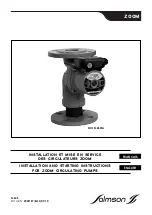
- 36 -
1. Causes of Trouble and Troubleshooting
(Note) Repair works marked by * are conducted by Iwaki.
Trouble
Causes
Countermeasures
Inspection and check points
Pump does not
operate.
Faulty selection of
electromagnetic valve
q
Inspect and repair or
replace.
a Use a quick exhaust valve if
corrosive gas influences.
Wear of valve or valve seat.
q
Replace pump head.*
Improper wiring or
disconnection in proximity
switch
q
Inspect and correct
wiring.
w
Replace if burned.*
a Check if the three wires are arranged
as described in the manual.
b Check air piping and wiring.
Bellows are damaged.
q
Replace pump head.*
a Check if supply air pressure is lower
than the specification.
b Check if pump stroke speed is lower
than the specification.
c Check if liquid temperature is lower
than the specification.
d Check if residual pressure is
removed upon pump stop.
e Check if air pipe is too narrow/ long.
f Check if suction pipe is narrowed.
Increased discharge pressure
in liquid feeling pipe
q
Inspect the filter and
replace it.
a Check filter for clogging or dry-up.
b Check if filter is well dampened.
w
Discharge-side valve
is closed.
a Open discharge-side valve.
Supply air pressure or air
volume is too low.
q
Set back to initial set
value. (Reset)
a Set pressure higher than min.
operation pressure for
electromagnetic valve.
b Secure a diameter and air flow rate
in consideration of the number of
pumps installed.a.
Malfunction of electrode
q
Remove the water
content from the wet
surface of the pump
and the air.
a. Take measures to protect the pump
from liquid.
b. Only completely dehumidified air
should be used for the air supply
Pump operates
but no liquid is
discharged.
Valve is clogged with
foreign matter (such as
fragments of wafer, etc.).
q
Replace pump head.*
w
Suction-side valve is
closed.
a Install pump guard filter or the like
on pump suction pipe.
a Open suction-side valve. Check if
valve route is blocked with
crystallized substance





































